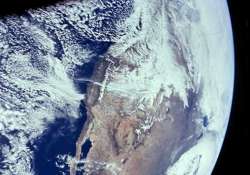Ozone layer recovery to take 40 years: Experts
Geneva, Sept 15: The ozone layer outside the Polar regions will take 40 years to recover to its pre-1980 levels, the World Meteorological Organization (WMO) said on Friday.Over the past decade, stratospheric ozone in the

Geneva, Sept 15: The ozone layer outside the Polar regions will take 40 years to recover to its pre-1980 levels, the World Meteorological Organization (WMO) said on Friday.
Over the past decade, stratospheric ozone in the Arctic and Antarctic regions as well as globally is no longer decreasing, but it has not yet started to recover either, Xinhua quoted senior scientific officer of WMO, Geir Braathen as saying.
The ozone layer over the Antarctic is expected to recover much later.
This year marks the 25th anniversary of the Montreal Protocol on substances that deplete the ozone layer, which was signed Sep 16, 1987.
It has succeeded in cutting the production and consumption of ozone-destroying chemicals, which have a long atmospheric lifetime.
But it will take several decades before their concentrations are back to pre-1980 levels.
The amount of ozone depleting gases in the Antarctic stratosphere reached a maximum around year 2000 and is now decreasing at a rate of about 1 percent every year.
According to the WMO's Antarctic Ozone Bulletin released Friday, as of mid September, the ozone hole is smaller than at the same time in 2011, but larger than in 2010.
The Antarctic ozone hole is an annually recurring phenomenon due to the existence of low temperatures in the stratosphere and the presence of ozone-depleting substances.
Over the past decade, stratospheric ozone in the Arctic and Antarctic regions as well as globally is no longer decreasing, but it has not yet started to recover either, Xinhua quoted senior scientific officer of WMO, Geir Braathen as saying.
The ozone layer over the Antarctic is expected to recover much later.
This year marks the 25th anniversary of the Montreal Protocol on substances that deplete the ozone layer, which was signed Sep 16, 1987.
It has succeeded in cutting the production and consumption of ozone-destroying chemicals, which have a long atmospheric lifetime.
But it will take several decades before their concentrations are back to pre-1980 levels.
The amount of ozone depleting gases in the Antarctic stratosphere reached a maximum around year 2000 and is now decreasing at a rate of about 1 percent every year.
According to the WMO's Antarctic Ozone Bulletin released Friday, as of mid September, the ozone hole is smaller than at the same time in 2011, but larger than in 2010.
The Antarctic ozone hole is an annually recurring phenomenon due to the existence of low temperatures in the stratosphere and the presence of ozone-depleting substances.